Garden Glimpses: Late Autumn Color
It’s November, and Nature is retreating from her active stance, but even as she presses pause on another season of fruitfulness, there is color and beauty everywhere you turn. The bounty of the harvest is still visible in every roadside farmstand, with bevvies of pumpkins, gourds and squashes in every imaginable hue, from classic oranges and yellows to reds, pinks, greens, whites, greys, even black. Solid, spotted, banded, freckled or striped; warted, grooved, bumpy or smooth, there’s something for every taste, and all still appropriate as seasonal décor, inside or out, through the looming Thanksgiving holiday.

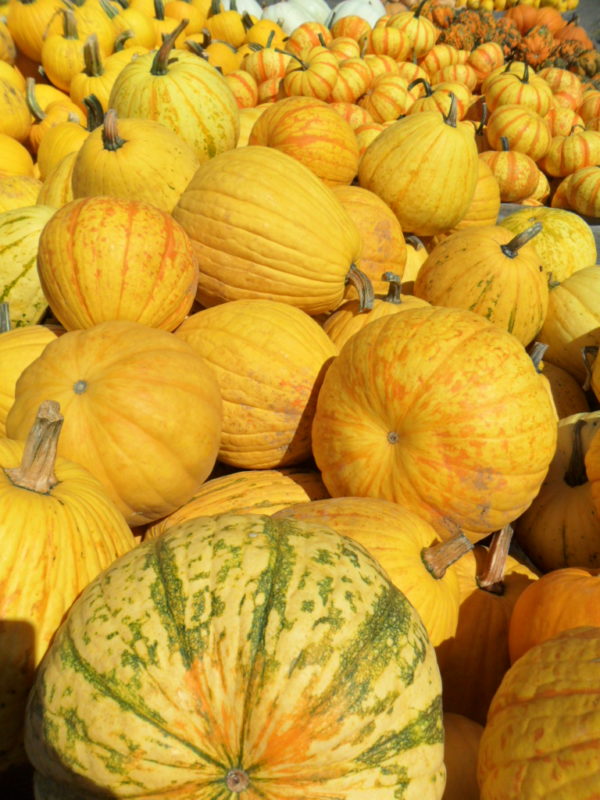
For intensity of color the deciduous trees of the American Northeast are unmatched. A severe drought over much of this summer season caused concern that autumn leaves might not be as bright, but the rains which returned after Labor Day came just in time to refresh root systems and rehydrate parched leaves before the cold set in, kicking off the show. After that, it was perfect coloring conditions, with crisp, frosty nights and warm sunny days, a combination that promotes the best autumn display. So it turned out to be a decent fall for foliage after all, with patches of vivid reds and oranges vying with bright yellow, rich golds, spectacular burgundy and purple, and some lovely rusty tones thrown in the mix to keep things real – it’s brown we’re headed for, after all.
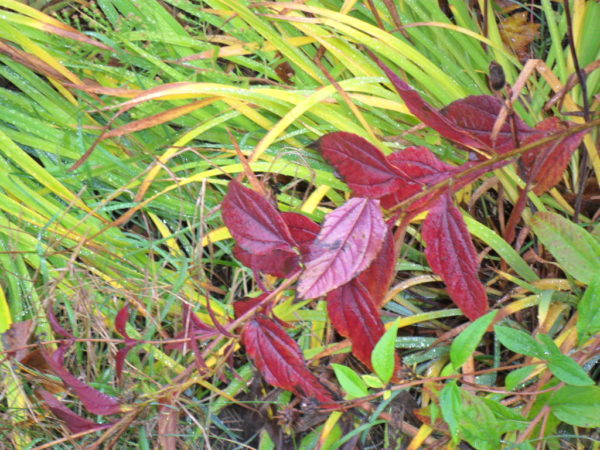
In my garden the leaf colors on shrubs and trees also exceeded expectations, and there was still quite a bit of play in floral displays as well. The Lemon Queen helianthus is long past peak of bloom, but shimmies into its autumn robes in style, with bright shafts of yellow, rusty brown, and deep magenta-purple leaves. Several other summer bloomers provide unexpected fall color, like the rich yellows of hosta, clumped under the maple in islands of seeming sunshine. Hardy native geranium leaves seethe in scarlet blushed with orange and purple, and often a bonus blossom is produced, lovely pale lavender against the fiery foliage.
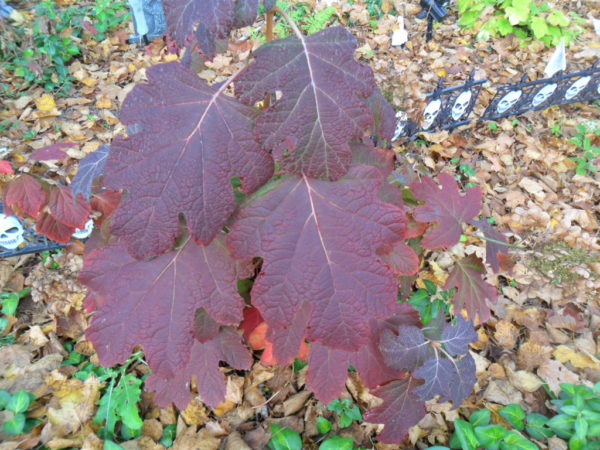
But the Best in Show for bonus fall color is the hydrangeas, noted for their wondrous flowers in July and August, huge multi-blossom aggregates extending up to a foot or more in length. By now, these have browned and are beginning to deteriorate, but the burst of color put out in an oakleaf hydrangea’s last gasp is truly marvelous to see. Foliage that was dull green is now shifting to bright scarlet, crimson, burgundy and purple-brown.
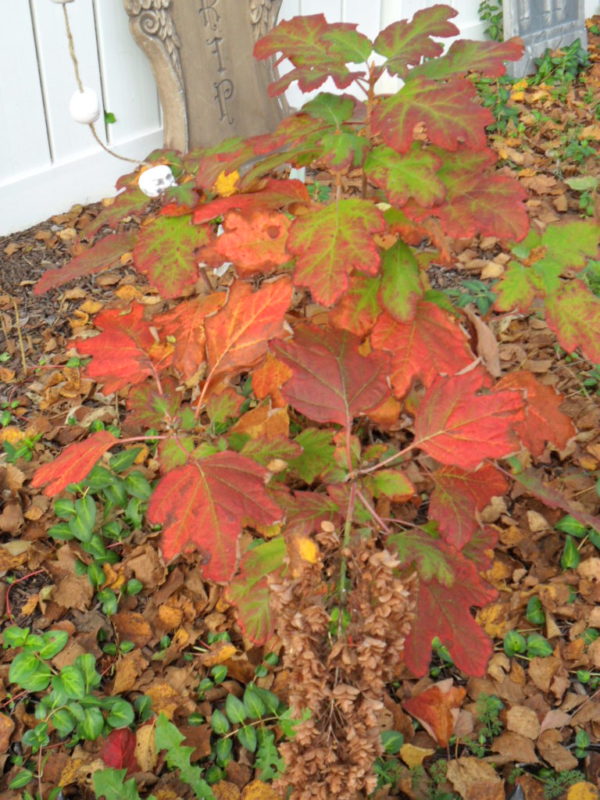
Snowflake inclines more to the red-orange end of the spectrum, while Pee Wee red-shifts towards burgundy puce. But Alice is the Queen of fall color, with vivid red scarlet leaves larger than a splayed hand. Alice has still been a disappointment on the floral front, the only oakleaf that has yet to truly flower for me (a single attempt last season mutated into a Japanese beetle-infested vestigial blossom), but if she keeps putting out color like this come November, I won’t care if she never blooms! Alice has been growing like a weed, and at maturity will be approximately eight feet by eight feet – I can’t imagine how spectacular that will look!
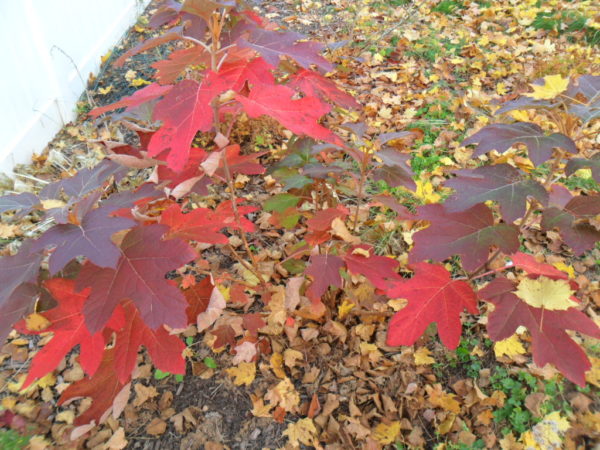
The aronias (chokeberries) are another reliable source of stunning color in late autumn. The black chokeberry flowered and fruited for the first time this year, just a few small clusters of berries, but the birds took these obsidian beauties almost immediately. Black chokeberry’s fall foliage is a gorgeous red-orange, but the issue I have is that it sheds leaves throughout the growing season, so that by the time autumn arrives, there’s not much left to enjoy on the skeletal branches. I’m unsure if the problem is moisture or light related, based on where it’s sited, or simply this plant’s nature, but the upside is that, even in the peak of summer heat, when it does drop leaves, they also color, providing random dots of fall just when I’m missing it most.
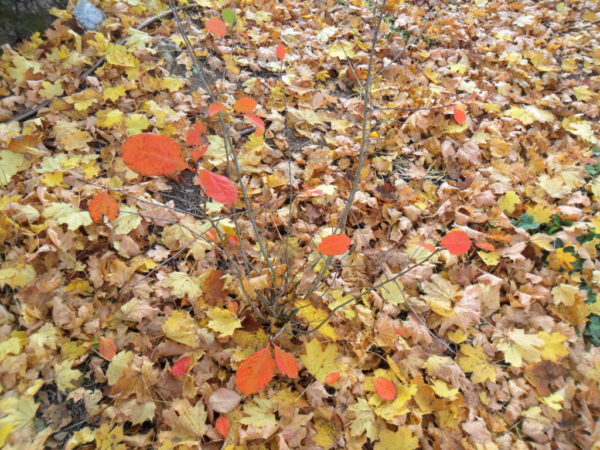
Red chokeberry fruits mature somewhat later, and so far, the birds don’t seem to have registered their presence. Plump and medium red, they are surrounded with matching crimson foliage that has a touch of purple. The issue here is this specimen’s structure – it has a bushy bottom and a bushy top, but not much between, with leggy stretches of branching that are essentially bare. By rights, I ought to cut off the tops and let it start again from the bottom, but it pains me to do that, so I’ll likely let it range in its misfit way, hoping someday it will fill in.

Trees provide good color as well, of course. The birches and maple that I inherited are all well and good in their medium yellow hues, but I have an eye for the dramatic, so I made choices for new arrivals that would increase the autumn palette over all. And there’s also one exception to the relative sedateness of the heirloom plantings: the Chinese dogwood. Positioned out front, this tree is a lovely three-season showstopper, with large creamy white blossoms in June that are so fully clustered they weigh down the branches; eyepopping pink-orange pimpled fruits in September; and vivid mixed shades of red, orange, yellow and purple foliage in November.

The tree’s one drawback is that, as a non-native, it’s supposedly an ecosystem dead end, with no nutritional value for the birds from its fruits. But this year I was surprised and pleased to note droves of catbirds and finches, even a few cardinals, who made regular foraging trips in its branches, pecking away at the fruits to expose the pale-yellow flesh, which they greedily devoured. So I felt pretty good about taking some of the saplings coming up at its base and transplanting them to form an arc across the front lawn. In time these will fill in and screen the house from the road in summer, helping to reduce the noise from the incessant traffic that has increased exponentially as more and more housing developments replace farmland in the township.
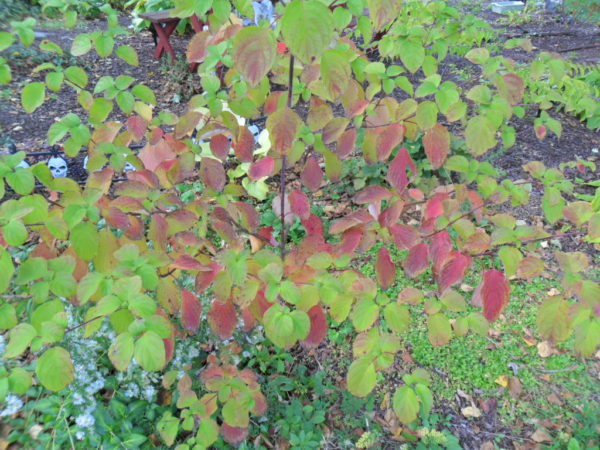
The newbie trees I’ve planted will add much to the fall landscape as they mature. The pair of cornus alternifolia, Pagoda dogwood, three years on the property, are finally reaching the stage where they are making an impact on the color scheme, and I have high hopes for their first bloom come spring. With mixed tones very similar to its Asian cousin, this native dogwood brings a welcome pop of fire tones in the blander birch and maple shade garden.
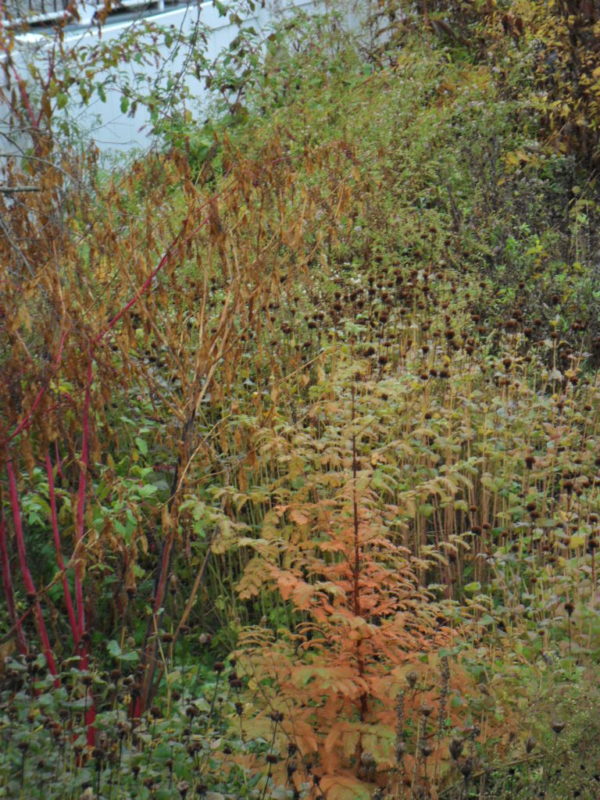
Similarly, the Dawn Redwood is shaking up things in its neck of the garden. I bought it, not two feet high, in a gallon pot two springs ago, and planted it to replace a failing clump of birch. It’s growing by leaps and bounds, and is already as tall as me; with delicate fronds of deep green needles that color bright cinnamon in autumn, Dawn Redwood’s bonus treat is that it’s deciduous, but the needles are so small they never need raking, and just melt into the soil over the winter. Lacy, delicate texture in summer, unique color in fall, and no messy clean-up? Winner, winner, turkey dinner!
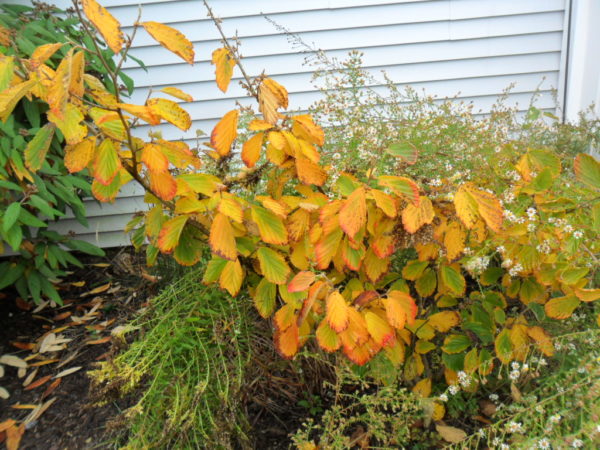
The witch hazel is also offering a good show this year, with its hatched leaves ranging in color from rich gold to orange and even touches of crimson. This small tree, the first to bloom in the late winter with blindingly bright yellow blossoms, lights up the east bed with its fall brilliance as well, making it one of my favorite new plantings.
An unexpected focus this year has been oak sapling transplants. I spotted one coming up at the lee of the Chinese dogwood shade a couple years ago, and early in the season, decided this fall would be the time to move it. As the summer wore on, I found three more; one was emerging in the lawn out front, so I quickly dug that out and potted it before the next grass cutting mowed it down. Two others came up inside the garden, one near the paper birch, another at the corner of the west daylily bed. Both were in acceptable locations, so I’m letting them run. The other two I’ve sited outside the garden fence, on the west side where I still own several yards of property, hoping in time they will help to fill in if the elder birch and maple fail on me, leaving an exposed shade garden. Now that fall is here, I can happily confirm that all are of the red to orange foliage variety, not more yellow for the garden.
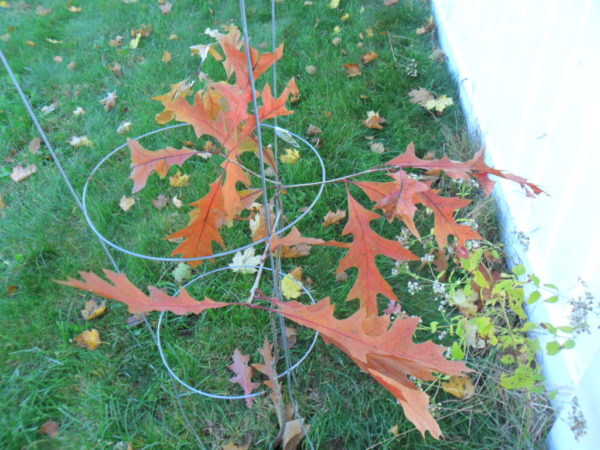
Where this bumper crop of oaks came from, I can’t imagine. There are no oaks nearby that I’m aware of, so it must be that some far-ranging and enterprising (but forgetful) squirrel has brought these acorns here. I’m very indebted to her regardless; oaks are perhaps the most useful tree in existence in this region, from a biodiversity support perspective. Countless species benefit and prosper from an oak, and a better horticultural investment in the planet’s future can’t be made.

There’s one more new addition that, for now, is awaiting its final home. I acquired a very small hawthorn stick sapling in the spring of 2021, a free gift for a small donation to the Arbor Day Foundation. Not sure it would survive, nor where to put it, I potted it; two autumns later, I’m still uncertain what to do with it. But it has prospered, and even in its pot, shows promise of lovely foliage to follow, a lively mix of reds, yellows and even purple, which will in time be accompanied by clusters of bright red berries, another avian favorite. About a foot tall now, I still have some time to decide where it belongs.

Although the heyday of summer florals is long past, there’s still some color from flowers. Most chrysanthemums purchased at nurseries and garden centers, though tagged as “hardy”, will likely not return. At least, that’s been my experience. I have had a few exceptions, one of which is a gorgeous bright purple mum, now in its third autumn here, and very much expanded in size, about a yard in diameter. It’s situated on top of the sandmound, near another, smaller mum with a dull red blossom. Visible from across the garden, it’s a lovely harbinger of the season, with bloom beginning in mid-September and extending for more than a month this year, prolonged by unseasonable cold.

A bright beacon of yellow in the late autumn garden is helianthus “Autumn Gold”, a perennial sunflower absolutely covered in vivid daisy-like blossoms. These emerge along the stems of this three-foot-tall variety, not just the tips, and tend to open all at once, providing a mass of very welcome color in the browning landscape about them.
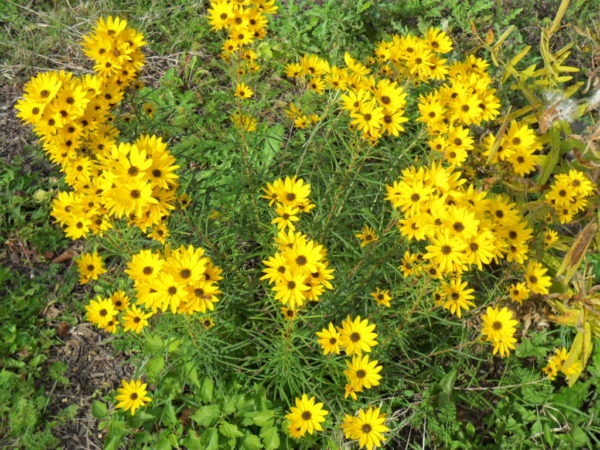
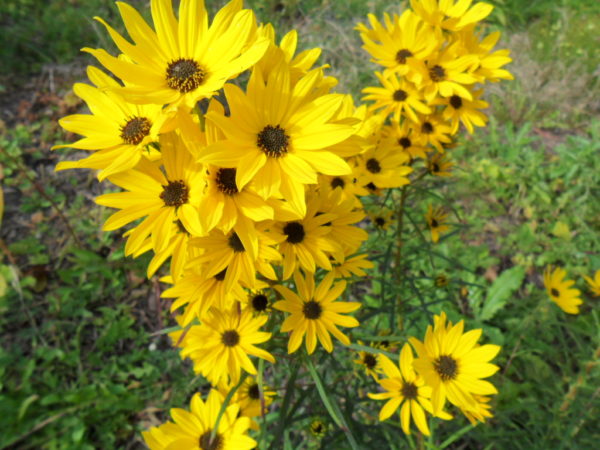
Montauk Daisy is probably the last to flower, not opening its bright white buds with butter-yellow centers until almost Halloween. This plant took a real battering from the drought this summer, losing leaves all along the stem, until what was left was just a tuft of leaf and bud at the terminus, looking like so many shaved poodle tails with fluffy pompom tips. But now that it’s in full flower, it still exudes a gracefulness that even a dry summer couldn’t completely erase.
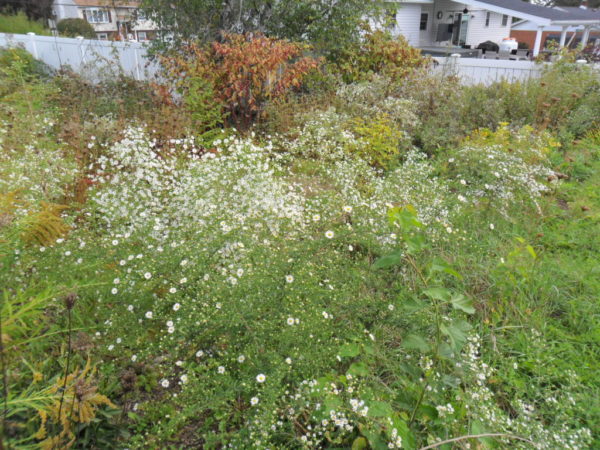
Of course there are natives still in bloom as well, growing more and more vigorous yearly. There are at least four different varieties of aster that self-sowed here, including snowy white Stiff Aster and pale lavender Michaelmas Daisy. Their blossoms, in large, dramatic sprays spread out all across the garden, are a sight for sore eyes, but also bring joy to the heart with the pollinators they attract. Before I converted the back and side yards into garden, it had been many years, possibly decades, since we’d seen more than the occasional random honeybee on the property. Now, three years later, they are frequent visitors, and as the asters put out the season’s final blossoms, they came in droves: dozens, perhaps hundreds of these endangered but vitally crucial insects massing on each clump to take advantage of the last sips of nectar.
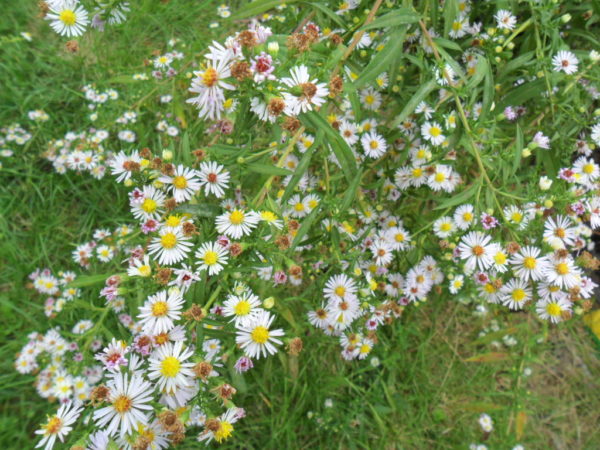
As November wanes, we’ll see less and less color in the garden, but its dying vegetation still retains a structural beauty and a practical purpose, as a home for insects and small critters to overwinter. After Thanksgiving I’ll put out the birdfeeders and suet cages, and welcome back my avian friends to the feast. With any luck, we’ll have good snow cover that will keep the perennial roots protected from the bitterest cold periods, and revive the garden with melted moisture come the spring.


4 comments, add yours.
edna
Spectacular! Thank you for sharing!
Mandy
I always look forward to your latest me-me-me posts 🍁🌹🌲💐
Laurien
I so enjoyed this, Alex, especially since I live mostly surrounded by evergreens. The hydrangea leaves are gorgeous. Sorry that urban sprawl is making your neighbourhood noisier. Glad you could provide the oak saplings with homes and the bees with nectar. You are doing your bit for the planet while creating beauty. Thanks for sharing!
Esperanza Acosta
Gracias lindas fotos